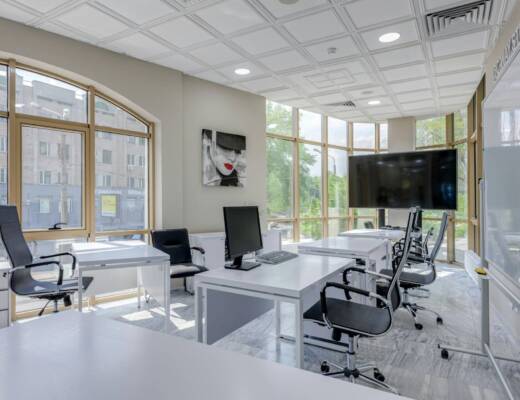Choosing the right surveillance system for your business is crucial for protecting your assets and ensuring safety. With so many options available, it’s important to understand your specific needs and what features will best serve your security requirements. This guide will help you navigate the key factors to consider when selecting a business surveillance system.
Key Takeaways
- Identify your security needs before making a purchase.
- Understand the differences between IP and analog cameras.
- Consider storage options like NVR, DVR, or cloud solutions.
- Check for compatibility with other security systems.
- Ensure you follow legal guidelines regarding surveillance.
Understanding Your Business Surveillance Needs

When I think about setting up a surveillance system for my business, the first step is to really understand what I need. Assessing my security requirements is crucial. I take a good look at my business space and figure out which areas need monitoring. This includes thinking about the size of my facility and the layout of the building.
Assessing Your Security Requirements
To start, I ask myself a few questions:
- What areas are most vulnerable?
- Do I need to monitor just the entrance, or do I also want to keep an eye on the inside?
- How many cameras will I need to cover these areas effectively?
This helps me determine my basic needs and ensures I’m not overspending on unnecessary features.
Identifying Key Areas for Monitoring
Next, I focus on identifying key areas that require surveillance. Here are some spots I always consider:
- Entry and exit points
- High-value inventory areas
- Secluded spots that might be overlooked
By pinpointing these areas, I can ensure that my surveillance system is tailored to my specific risks.
Balancing Budget and Security
Finally, I have to balance my budget with my security needs. It’s important to remember that just because a system is expensive doesn’t mean it’s the best fit for my business. I look for options that provide the best value while meeting my requirements.
Understanding my surveillance needs helps me avoid unauthorized surveillance that can give others a detailed understanding of my business operations.
In summary, taking the time to assess my needs, identify key areas, and balance my budget is essential for choosing the right surveillance system for my business.
Types of Surveillance Cameras and Their Applications

When it comes to choosing the right surveillance cameras for my business, I find it essential to understand the different types available and their specific uses. Each type of camera serves a unique purpose, and knowing these can help me make an informed decision.
IP Cameras vs. Analog Cameras
- IP Cameras: These cameras connect to the internet and can provide high-resolution images, often ranging from 1 to 5 megapixels. They are great for detailed monitoring and can be accessed remotely.
- Analog Cameras: These are the traditional cameras that use coaxial cables. They usually offer lower resolution, around 0.5 megapixels, but can still be effective for basic surveillance needs.
| Feature | IP Cameras | Analog Cameras |
|---|---|---|
| Resolution | 1-5 Megapixels | 0.5 Megapixels |
| Connectivity | Internet | Coaxial Cable |
| Remote Access | Yes | No |
Dome, Bullet, and PTZ Cameras
- Dome Cameras: These are often used indoors due to their discreet design. They blend well with the environment and are less likely to be tampered with.
- Bullet Cameras: Ideal for outdoor use, these cameras have a longer range and are designed to withstand various weather conditions.
- PTZ Cameras: These cameras can pan, tilt, and zoom, making them perfect for areas that require detailed observation.
Special Features: Night Vision and Motion Detection
Having cameras with special features can significantly enhance security. Here are some features I consider:
- Night Vision: This allows cameras to capture clear images in low-light conditions, ensuring 24/7 monitoring.
- Motion Detection: Cameras with this feature only record when movement is detected, saving storage space and making it easier to review footage.
Choosing the right type of camera is crucial for effective surveillance. It not only helps in monitoring but also in preventing potential incidents.
By understanding these different types of cameras and their applications, I can better tailor my surveillance system to meet my business’s specific needs. This way, I ensure that I am investing in a system that provides both security and peace of mind.
Storage Solutions for Surveillance Footage
When it comes to storing surveillance footage, I’ve learned that there are several options to consider. Choosing the right storage solution is crucial for ensuring that your video data is safe and accessible when you need it.
NVR vs. DVR Systems
First, let’s talk about the two main types of video recorders: NVR (Network Video Recorder) and DVR (Digital Video Recorder). Here’s a quick comparison:
| Feature | NVR | DVR |
|---|---|---|
| Camera Type | IP Cameras | Analog Cameras |
| Installation | Easier for IP systems | More complex |
| Video Quality | Higher resolution | Lower resolution |
Cloud Storage Options
Next, I find that cloud storage is becoming increasingly popular. It allows me to access my footage from anywhere. Here are some benefits of using cloud storage:
- Remote access to videos
- Protection against hardware damage
- Scalable storage options
However, I need to be cautious about bandwidth usage. It’s best to schedule uploads during off-peak hours to avoid slowing down my network.
Hybrid Storage Solutions
Lastly, hybrid storage combines both local and cloud storage. This way, I can keep important footage on-site while also having a backup in the cloud. It’s a smart way to ensure that I don’t lose any critical data.
In my experience, having a mix of storage solutions can provide the best security for your footage. It’s all about finding the right balance for your business needs.
By understanding these storage options, I can make informed decisions that will help protect my business effectively. Remember, the right storage solution can make all the difference in keeping your surveillance footage safe and accessible!
Integration with Other Security Systems
When I think about setting up a business surveillance system, one of the first things that comes to mind is how well it can work with other security systems. A well-integrated system can make a huge difference in overall security. Here are some key areas to consider:
Access Control Integration
- Integrating with access control systems helps manage who can enter certain areas.
- This ensures that only authorized personnel can access sensitive locations.
- It streamlines security management, making it easier to monitor entry points.
Alarm System Compatibility
- A good surveillance system should work seamlessly with alarm systems.
- This allows for quick responses to any security breaches.
- When an alarm goes off, the cameras can automatically focus on the area of concern.
Perimeter Security Enhancements
- Integrating with perimeter security systems can provide an extra layer of protection.
- This includes motion detectors and barriers that alert you to potential threats.
- A unified system can help in coordinating responses to incidents more effectively.
By ensuring that your surveillance system can easily connect with other security measures, you can create a more comprehensive security strategy.
In summary, choosing a surveillance system that integrates well with other security systems is essential. It not only enhances security but also makes managing your overall security operations much easier. This way, you can focus on running your business while knowing that your security is in good hands.
Remember, a cohesive security system is key to protecting your business effectively!
Legal and Compliance Considerations
Understanding Surveillance Laws
When I set up a surveillance system, I always make sure to understand the laws that apply to my business. Different states have different rules about where I can place cameras and how I can use the footage. For example, I can film in areas where people don’t expect privacy, like a store floor, but not in places like bathrooms. Knowing these laws helps me avoid legal trouble.
Privacy Concerns and Best Practices
I also think about privacy when using surveillance cameras. It’s important to be open with my employees and visitors about why I have cameras. Here are some best practices I follow:
- Inform everyone about the cameras and their purpose.
- Limit camera placement to areas where privacy is not expected.
- Secure the footage to prevent unauthorized access.
Employee and Visitor Notification
Lastly, I make sure to notify both employees and visitors about the surveillance. This can be done through signs or direct communication. Keeping everyone informed helps build trust and ensures that I’m following the law.
Being transparent about surveillance not only keeps me compliant but also fosters a sense of security among my staff and customers.
In summary, understanding the legal landscape and prioritizing privacy are key steps in setting up a surveillance system that protects my business while respecting the rights of others.
Key Takeaway: Always stay informed about local laws and best practices to ensure compliance and maintain trust.
Future-Proofing Your Surveillance System

When I think about setting up a surveillance system, I always consider how it can grow with my business. Choosing a system that can expand easily is key. This means I can add more cameras or features without starting from scratch. Here are some important points to keep in mind:
Scalability for Business Growth
- Easy Expansion: Look for systems that allow you to add cameras or storage as needed.
- Modular Design: A system that can be upgraded piece by piece saves time and money.
- Future Needs: Think about what your business might need in a few years.
Compatibility with Emerging Technologies
- Stay Updated: Make sure the system can work with new tech like AI and cloud storage.
- Integration: It should connect easily with other security systems, like alarms or access control.
- Flexibility: A system that adapts to new technologies will keep your security strong.
Ensuring System Durability and Reliability
- Weather Resistance: Choose cameras that can handle rain, snow, and extreme temperatures.
- Proven Performance: Look for systems with a good track record in various conditions.
- Regular Updates: Ensure the system can be updated easily to keep it running smoothly.
By planning for the future, I can make sure my surveillance system remains effective and relevant as my business grows.
In summary, when I invest in a surveillance system, I want it to be a smart choice that protects my business today and tomorrow. Future-proofing my security means I can focus on running my business without worrying about my safety measures becoming outdated.
Professional Installation and Maintenance

DIY vs. Professional Installation
When it comes to setting up a surveillance system, I often find myself weighing the options between doing it myself or hiring a professional. Professional installation can save time and ensure everything is set up correctly. Here are some reasons to consider professional help:
- Expertise: Professionals know the best practices for camera placement and system setup.
- Time-Saving: They can complete the installation much faster than I could on my own.
- Warranty Protection: Many vendors require professional installation to maintain warranties.
Regular Maintenance and Upgrades
Once the system is installed, it’s crucial to keep it running smoothly. Regular maintenance can prevent issues before they arise. Here’s what I recommend:
- Scheduled Check-ups: Regularly inspect the system to catch any potential problems early.
- Software Updates: Keeping the software up-to-date helps protect against vulnerabilities.
- Performance Optimization: Adjust settings and camera angles to ensure the best coverage.
Choosing a Reliable Vendor
Finding a trustworthy vendor is key to a successful surveillance system. I look for:
- Customer Support: A vendor that offers responsive support can make a big difference.
- Quality Products: High-quality cameras and equipment ensure reliability.
- Comprehensive Service Agreements: These should cover maintenance and updates to keep the system effective.
Investing in professional installation and regular maintenance is essential for maximizing the effectiveness of my surveillance system. It not only enhances security but also provides peace of mind.
In conclusion, whether I choose to install the system myself or hire a professional, maintaining it is crucial for long-term success. A well-maintained system can deter crime and protect my business.
Conclusion
In summary, selecting the right video surveillance system for your business is a careful process that requires thoughtful consideration of various factors. Start by identifying your specific security needs, such as which areas you want to monitor and how many cameras you will need. It’s also important to look at the technology features, like video quality and storage options, to ensure they meet your requirements. Take the time to research different systems, compare prices, and read customer reviews to make an informed choice. Remember, a good surveillance system not only protects your business but also helps create a safer environment for everyone.
Frequently Asked Questions
What should I consider before buying a surveillance system?
Before purchasing, think about what areas you need to monitor and how many cameras you will require. Also, consider your budget and the features that are most important to you.
What are the main types of surveillance cameras?
The two main types are IP cameras, which connect to the internet and offer higher quality images, and analog cameras, which are older and less advanced.
How do I store the footage from my surveillance cameras?
You can store footage using DVR systems for analog cameras, NVR systems for IP cameras, or cloud storage options that keep your data online.
Can I integrate my surveillance system with other security measures?
Yes, many surveillance systems can work with access control systems and alarms to create a more comprehensive security setup.
What are the legal issues I should be aware of?
It’s important to understand local laws about surveillance, including where cameras can be placed and how to inform employees and visitors about monitoring.
How can I make sure my surveillance system lasts?
Choose a system that can grow with your business and is compatible with new technologies. Also, select durable equipment that can withstand tough weather.







